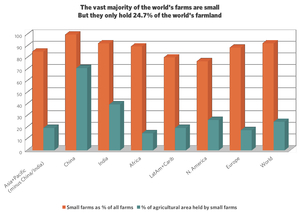A World of Demands on Our Farmlands
May 29th, 2014 | By admin | Category: Food and Hunger/AgricultureBy Suzanne York, www.howmany.org.
Carbon footprint size is often talked about, but what about agriculture’s footprint?
Farming of crops and livestock uses more than 38 percent of the planet’s ice-free land. Humans have cleared land that amounts to nearly the size of South America to grow crops and to raise livestock, cleared an area almost the size of Africa.
Small Scale Farmers Feed the WorldLooking beyond the size of agriculture’s footprint, it is important to take into account the role of small farmers in feeding their communities, especially as world population increase nearly 35 percent by 2050, to 9 billion people.
A report by the respected organization GRAIN, which supports small farmers and social movements in their struggles for community-controlled and biodiversity-based food systems, found that small farms, which produce most of the world’s food, are currently squeezed onto less than a quarter of the world’s farmland – or less than one fifth if you leave out China and India.
“We are fast losing farms and farmers through the concentration of land into the hands of the rich and powerful,” said Henk Hobbelink, coordinator of GRAIN. “The overwhelming majority of farming families today have less than two hectares to cultivate and that share is shrinking. If we do nothing to reverse this trend, the world will lose its capacity to feed itself.”
Just last week, another report analyzed the impact of climate change and food and agriculture. Researchers of Advancing Global Food Supply in the Face of a Changing Climate predict that the collapse of a large part of the Antarctic ice sheet – already underway – could devastate global food supply, drowning vast areas of crop lands across the Middle East and Asia.
Corporate-controlled farms and the industrial agriculture system, combined with climate change, are pushing small-holder farmers off of their lands and out of farming.
From land grabs to expansion of monocultures, GRAIN’s data concluded that “control over land is being usurped from small producers and their families, with elites and corporate powers pushing people onto smaller and smaller land holdings, or off the land entirely into camps or cities.”
Overall, the report’s authors came to six major conclusions:
- The vast majority of farms in the world today are small and getting smaller
- Small farms are currently squeezed onto less than a quarter of the world’s farmland
- We are fast losing farms and farmers in many places, while big farms are getting bigger
- Small farms continue to be the major food producers in the world
- Small farms are overall more productive than big farms
- Most small farmers are women
Ending Poverty
In order to feed everyone, there are certain measures that can be implemented that will improve the chances of billions being well-fed. This includes land reform, less corporate-controlled farms, land rights for women, education, sustainable livelihoods, conservation and efficiency.
Feeding the world and ending hunger also means ending poverty and inequality. About 20 percent of the world’s population, 1.2 billion people, live on less than $1 a day, many of whom farm small, marginal plots of land. Boosting their rights, along with their agriculture yields, needs to be at the top of the global priority list.
And even as poor people are able to get out of poverty, the role of small farmers is great. A recent U.S. National Intelligence Council assessment found that by 2030, population growth and a burgeoning global middle class will result in a 35 percent increase in demand for food.
Recognizing the Contributions of Farmers
Small farmers often twice as productive as large farms and are more environmentally sustainable, making use of local biodiversity and using practices rooted in agro-ecology. In fact, various UN agencies have estimated that small farmers produce up to 80% of the food in the non-industrialized countries.
GRAIN’s conclusion is that “We need to urgently put land back in the hands of small farmers and make the struggle for agrarian reform central to the fight for better food systems.”
Suzanne York is a senior writer with the Institute for Population Studies.


